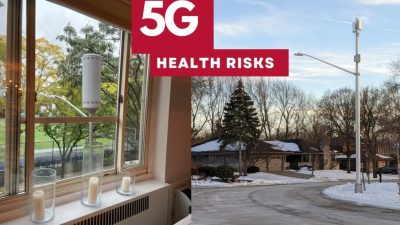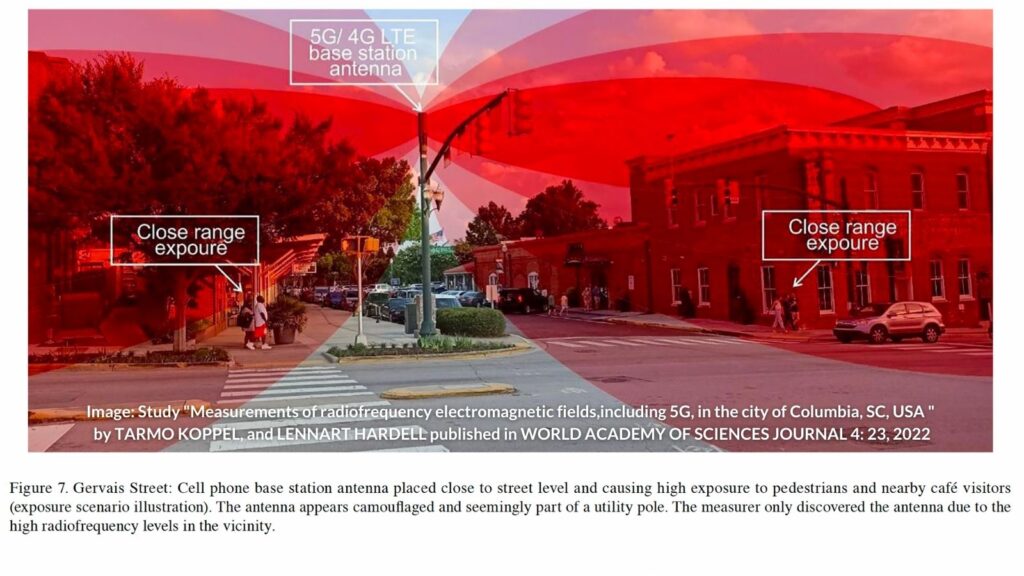by Environmental Health Trust, Global Research:

The European Parliament requested a research report “Health Impact of 5G” which was released in July 2021 and concluded that commonly used RFR frequencies (450 to 6000 MHz) are probably carcinogenic for humans and clearly affect male fertility with possible adverse effects on the development of embryos, fetuses and newborns.
Cell towers, 5G Networks and 4G Small Cells Emit Radiofrequency (RF) Radiation
Studies find RF exposure elevated in buildings located close to cell antennas.
Baltrėnas et al 2012 investigated RF power density levels from cell phone antennas located 35 meters away from a 10-story apartment building. The transmitting antennas were approximately at the same height as the 6th floor of the building. The researchers found the highest RF at floors 5–7. The RF at the 6th floor balcony was three times higher than the 3rd floor balcony. The RF power density at the 6th floor was about 15 times the RF measures at the first floor.
TRUTH LIVES on at https://sgtreport.tv/
The study “Radiofrequency radiation from nearby mobile phone base stations-a case comparison of one low and one high exposure apartment “ published in Oncology Letters (Koppel et al 2019) found that the apartment with high RF exposure had outdoor areas as close as 6 meters (about 19.6 feet) from the cell antenna array. In contrast, the low exposure apartment’s balcony had cell antennas at 40 meters (about 131 feet) away. The researchers also found that both apartments had good mobile phone reception and “Therefore, installation of base stations to risky places cannot be justified using the good reception requirement argument.”
A 2017 case report of RF levels in an apartment close to two groups of rooftop cellular antennas used an exposimeter to measure levels of different types of RF in the apartment and balconies including TV, FM, TETRA emergency services, 2G GSM, 3G UMTS, 4G LTE, DECT cordless, Wi-Fi 2.4 GHz and 5 GHz and WiMAX. The closest transmitting antennas were at a base station 6 meters from the balcony. The researchers documented a number of important findings. First, 97.9% of the mean RF radiation was caused by downlink from the 2G, 3G and 4G base stations. (Downlink means frequencies emitted “down” from the base station cellular antennas.) The researchers found that if the base station RF emissions were excluded, the RF radiation in the children’s bedrooms was reduced ~99%. The researchers conclude that, “due to the current high RF radiation, the apartment is not suitable for long‑term living, particularly for children who may be more sensitive than adults.”
Outdoor levels of RF are increasing from the densification of wireless networks
A study measuring RF EMF exposure in the European cities of Basel, Ghent and Brussels found total RF exposure levels in all investigated outdoor locations had increased up to 57.1% in one year (April 2011 to March 2012). The RF increase was most notably observed in outdoor locations due to mobile phone base stations. Urbinello et al., 2014
A 2018 study published in Oncology Letters documented measurements of “unnecessarily high” radiofrequency (RF) radiation levels in several locations in Stockholm, Sweden. The authors conclude “Using high-power levels causes an excess health risk to many people. Even higher RF radiation is expected when 5G is implemented.”
A 2018 study by Hardell et al published in the World Academy of Sciences Journal found the RF levels at Järntorget square in Stockholm Old Town Sweden (measured in April, 2016) were only one order of magnitude lower than the RF levels associated with an increased incidence of tumors in the Ramazzini radiofrequency animal study (Falcioni et al 2018) which exposed rats to a lifetime of RF mimicking cell tower base station exposures. The authors concluded that, “These results indicate that an increased cancer risk may be the situation for individuals staying at the square, primarily for those working in shops and cafés around the square. We have not measured RF radiation emissions in apartments around the square. It cannot be excluded that at certain places, the radiation may even be higher…”
A 2017 study of Royal Castle, Supreme Court, three major squares and the Swedish Parliament found despite the hidden architecturally camouflaged antennas, the passive exposure to RF radiation from cell antennas can be higher than RF levels associated with non thermal biological effects. Some of the highest levels were from antennas closer to the ground and targeted towards the square. The researchers note that the heaviest RF load falls on people working or living near hotspots, compared to people that are walking by and briefly exposed. RF measurements from earlier published studies were compared to the 2017 measurements indicating that “it is clear from our present and previous studies that the level of ambient RF radiation exposure is increasing.”
A 2016 study at Stockholm Central Railway Station in Sweden documented higher RF levels in areas where base station antennas were located closest to people. Importantly, the RF from the downlink of UMTS, LTE, GSM base station antennas contributed to most of the radiation levels.
A 2022 study “Very high radiofrequency radiation at Skeppsbron in Stockholm, Sweden from mobile phone base station antennas positioned close to pedestrians’ heads” created an RF heat map of RF measurements finding that the highest RF measurements were in areas of close proximity to the base station antennas. The researchers concluded with recommendations to reduce close proximity placements such as positioning antennas “as far as possible from the general public” like in high elevation locations or remote areas.
A 2022 study in the World Academy of Sciences Journal measured levels of radiofrequency radiation (RFR), from wireless networks including 5G, in the city of Columbia, South Carolina and found the highest RFR levels in areas where the cell phone base station antennas were placed on top of utility poles, street lamps, traffic lights or other posts near to the street. When the scientists compared their 2022 findings to a 2019 published review on the mean outdoor exposure level of European cities, they found the Columbia, South Carolina measurements to be the highest. The Columbia, S.C. study concluded that the highest exposure areas were due to two reasons: cell phone base antennas on top of high-rise buildings provide “good cell coverage reaching far away, but creating elevated exposure to the radiofrequency electromagnetic fields at the immediate vicinity; and cell phone base station antennas installed on top of utility poles have placed the radiation source closer to humans walking on street level.”

Image from Koppel T and Koppel T: Measurements of radiofrequency electromagnetic fields, including 5G, in the city of Columbia, SC, USA. World Acad Sci J 4: 22, 2022
Published Reviews That Recommend Cell Towers Be Distanced Away From Homes and Schools
- A review paper entitled “Limiting liability with positioning to minimize negative health effects of cellular phone towers” reviewed the “large and growing body of evidence that human exposure to RFR from cellular phone base stations causes negative health effects.” The authors recommend restricting antennas near home and within 500 meters of schools and hospitals to protect companies from future liability (Pearce 2020).
- An analysis of 100 studies published in Environmental Reviews found ~80% showed biological effects near towers. “As a general guideline, cell base stations should not be located less than 1500 ft from the population, and at a height of about 150 ft.” (Levitt 2010)
- A review published in the International Journal of Occupational and Environmental Health found people living less than 500 m from base station antennas had an increased adverse neuro-behavioral symptoms and cancer in eight of the ten epidemiological studies (Khurana 2011).
- A paper by human rights experts documented the accumulating science indicating safety is not assured and considered the issue within a human rights framework to protect vulnerable populations from environmental pollution. “We conclude that, because scientific knowledge is incomplete, a precautionary approach is better suited to State obligations under international human rights law.” (Roda and Perry 2014)
- A review entitled “Evidence for a health risk by RF on humans living around mobile phone base stations: From radiofrequency sickness to cancer reviewed the existing scientific literature and found radiofrequency sickness, cancer and changes in biochemical parameters. (Balmori 2022)
Cell Towers Radiofrequency Radiation and Cancer: World Health Organization International Agency for Research on Cancer
In 2011, radiofrequency radiation was classified as a Class 2B possible carcinogen by the World Health Organization’s International Agency for Research on Cancer (WHO/IARC). The WHO/IARC scientists clarified that this determination was for RFR from any source be it cell phones, wireless devices or cell towers. Since 2011, the published peer-reviewed scientific evidence associating RFR to cancer and other adverse effects has significantly increased.
In 2019, the WHO/IARC advisory committee recommended that radiofrequency radiation be re-evaluated as a “high” priority in light of the new research. The date of the re-evaluation has not been set.




